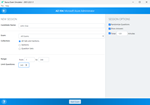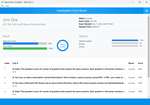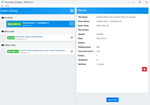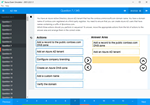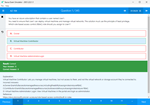Download MuleSoft Certified Developer - Level 2 (Mule 4).MCD-Level-2.ExamDumps.2024-06-17.29q.tqb
| Vendor: | Mulesoft |
| Exam Code: | MCD-Level-2 |
| Exam Name: | MuleSoft Certified Developer - Level 2 (Mule 4) |
| Date: | Jun 17, 2024 |
| File Size: | 3 MB |
How to open TQB files?
Files with TQB (Taurus Question Bank) extension can be opened by Taurus Exam Studio.
Purchase
Coupon: TAURUSSIM_20OFF
Discount: 20%
Demo Questions
Question 1
The flow is invoicing a target API. The API's protocol is HTTPS. The TLS configuration in the HTTP Request Configuration global element is set to None. A web client submits a request to http:localhost:8081/vehicles.

If the certificate of the target API is signed by a certificate authority (CA), what is true about the HTTP Request operation when the flow executes?
- The HTTP Request operation will succeed if the CA'S certificate is present in the JRE's default keystore
- The HTTP Request operation will succeed if the CA's certificate is present in the JRE's default truststore.
- The HTTP Request operation will always succeed regardless of the CA
- The HTTP Request operation will always fail regardless of the CA
Correct answer: B
Explanation:
The HTTP Request operation will use the default truststore of the JRE to validate the certificate of the target API. If the CA's certificate is present in the truststore, the operation will succeed. Otherwise, it will fail with a handshake exception.Reference: https://docs.mulesoft.com/mule-runtime/4.3/tls-configuration#tls-default The HTTP Request operation will use the default truststore of the JRE to validate the certificate of the target API. If the CA's certificate is present in the truststore, the operation will succeed. Otherwise, it will fail with a handshake exception.
Reference: https://docs.mulesoft.com/mule-runtime/4.3/tls-configuration#tls-default
Question 2
When a client and server are exchanging messages during the mTLS handshake, what is being agreed on during the cipher suite exchange?
- A protocol
- The TLS version
- An encryption algorithm
- The Public key format
Correct answer: C
Explanation:
A cipher suite is a set of cryptographic algorithms that are used to secure the communication between a client and a server. A cipher suite consists of four components: a key exchange algorithm, an authentication algorithm, an encryption algorithm, and a message authentication code (MAC) algorithm. During the cipher suite exchange, the client and the server agree on which encryption algorithm to use for encrypting and decrypting the data.Reference: https://docs.mulesoft.com/mule-runtime/4.3/tls-configuration#cipher-suites A cipher suite is a set of cryptographic algorithms that are used to secure the communication between a client and a server. A cipher suite consists of four components: a key exchange algorithm, an authentication algorithm, an encryption algorithm, and a message authentication code (MAC) algorithm. During the cipher suite exchange, the client and the server agree on which encryption algorithm to use for encrypting and decrypting the data.
Reference: https://docs.mulesoft.com/mule-runtime/4.3/tls-configuration#cipher-suites
Question 3
A healthcare portal needs to validate the token that it sends to a Mule API. The developer plans to implement a custom policy using the HTTP Policy Transform Extension to match the token received in the header from the heathcare portal.
Which files does the developer need to create in order to package the custom policy?
- Deployable ZIP file, YAML configuration file
- JSON properties file, YAML configuration file
- JSON properties file, XML template file
- XML template file, YAML configuration file
Correct answer: D
Explanation:
To package a custom policy using the HTTP Policy Transform Extension, the developer needs to create an XML template file and a YAML configuration file. The XML template file defines the policy logic using Mule components and placeholders for user-defined properties. The YAML configuration file defines the metadata of the policy, such as its name, description, category, parameters, and dependencies.Reference: https://docs.mulesoft.com/api-manager/2.x/http-policy-transform#packaging-the-policy To package a custom policy using the HTTP Policy Transform Extension, the developer needs to create an XML template file and a YAML configuration file. The XML template file defines the policy logic using Mule components and placeholders for user-defined properties. The YAML configuration file defines the metadata of the policy, such as its name, description, category, parameters, and dependencies.
Reference: https://docs.mulesoft.com/api-manager/2.x/http-policy-transform#packaging-the-policy
Question 4
Refer to the exhibit.

What action must be performed to log all the errors raised by the VM Connector?
- Add <AsyncLOgger name='orgroute.extensions vm' level=ERROR'I> inside the Logger tag
- Add <AsyncLOgger name='orgroute.extensions vm' level=ERROR'/> inside the Appenders tag
- Configure <Logger level-'ERROR'/> inside the VM Connector configuration
- Nothing, as error-level events are automatically logged
Correct answer: B
Explanation:
To log all the errors raised by the VM Connector, the developer needs to add an async logger with the name 'org.mule.extension.vm' and the level 'ERROR' inside the appenders tag of the log4j2.xml file. This will enable logging all error-level events generated by the VM Connector to the console appender.Reference: https://docs.mulesoft.com/mule-runtime/4.3/logging-in-mule#configuring-custom-logging-settings To log all the errors raised by the VM Connector, the developer needs to add an async logger with the name 'org.mule.extension.vm' and the level 'ERROR' inside the appenders tag of the log4j2.xml file. This will enable logging all error-level events generated by the VM Connector to the console appender.
Reference: https://docs.mulesoft.com/mule-runtime/4.3/logging-in-mule#configuring-custom-logging-settings
Question 5
A developer deploys an API to CloudHub and applies an OAuth policy on API Manager. During testing, the API response is slow, so the developer reconfigures the API so that the out-of-the-box HTTP Caching policy is applied first, and the OAuth API policy is applied second.
What will happen when an HTTP request is received?
- In case of a cache hit, both the OAuth and HTTP Caching policies are evaluated; then the cached response is returned to the caller
- In case of a cache it, only the HTTP Caching policy is evaluating; then the cached response is returned to the caller
- In case of a cache miss, only the HTTP Caching policy is evaluated; then the API retrieves the data from the API implementation, and the policy stores the data to be cached in Object Store
- In case of a cache miss, both the OAuth and HTTP Caching policies are evaluated; then the API retrieves the data from the API implementation, and the policy does not store the data in Object Store
Correct answer: B
Explanation:
When an HTTP request is received and the HTTP Caching policy is applied first, it checks if there is a cached response for that request in Object Store. If there is a cache hit, meaning that a valid cached response exists, then only the HTTP Caching policy is evaluated and the cached response is returned to the caller without invoking the OAuth policy or the API implementation. If there is a cache miss, meaning that no valid cached response exists, then both the HTTP Caching policy and the OAuth policy are evaluated before invoking the API implementation.Reference: https://docs.mulesoft.com/api-manager/2.x/http-caching-policy#policy-ordering When an HTTP request is received and the HTTP Caching policy is applied first, it checks if there is a cached response for that request in Object Store. If there is a cache hit, meaning that a valid cached response exists, then only the HTTP Caching policy is evaluated and the cached response is returned to the caller without invoking the OAuth policy or the API implementation. If there is a cache miss, meaning that no valid cached response exists, then both the HTTP Caching policy and the OAuth policy are evaluated before invoking the API implementation.
Reference: https://docs.mulesoft.com/api-manager/2.x/http-caching-policy#policy-ordering
HOW TO OPEN VCE FILES
Use VCE Exam Simulator to open VCE files

HOW TO OPEN VCEX FILES
Use ProfExam Simulator to open VCEX files


ProfExam at a 20% markdown
You have the opportunity to purchase ProfExam at a 20% reduced price
Get Now!